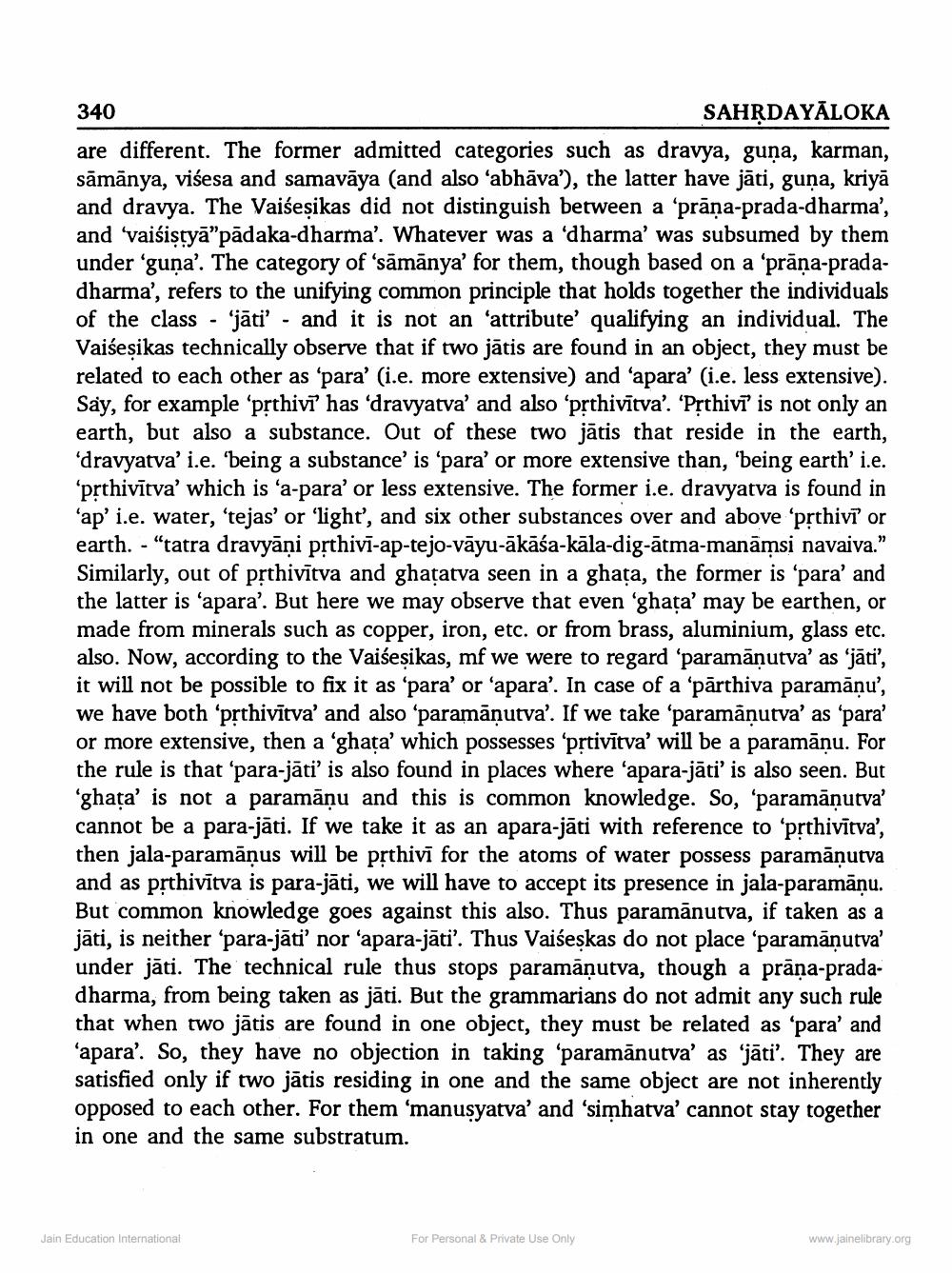________________
340
SAHRDAYĀLOKA are different. The former admitted categories such as dravya, guna, karman, sāmānya, višesa and samavāya (and also 'abhāva'), the latter have jāti, guna, kriyā and dravya. The Vaiseșikas did not distinguish between a 'prāņa-prada-dharma', and 'vaisistyā"pādaka-dharma'. Whatever was a 'dharma' was subsumed by them under 'guna'. The category of 'sāmānya' for them, though based on a 'prāna-pradadharma', refers to the unifying common principle that holds together the individuals of the class - 'jāti' - and it is not an 'attribute qualifying an individual. The Vaiseșikas technically observe that if two jātis are found in an object, they must be related to each other as 'para' (i.e. more extensive) and 'apara' (i.e. less extensive). Say, for example 'prthivi' has 'dravyatva' and also 'prthivītva'. 'Prthivi' is not only a earth, but also a substance. Out of these two jātis that reside in the earth, 'dravyatva' i.e. being a substance' is 'para' or more extensive than, 'being earth' i.e. 'prthivītva' which is ‘a-para' or less extensive. The former i.e. dravyatva is found in 'ap' i.e. water, 'tejas' or 'light', and six other substances over and above 'prthivi' or earth. - "tatra dravyāni prthivī-ap-tejo-vāyu-ākāśa-kāla-dig-ātma-manāmsi navaiva.” Similarly, out of prthivītva and ghatatva seen in a ghata, the former is 'para' and the latter is ‘apara'. But here we may observe that even 'ghata' may be earthen, or made from minerals such as copper, iron, etc. or from brass, aluminium, glass etc also. Now, according to the Vaiseșikas, mf we were to regard 'paramānutva' as 'jāti', it will not be possible to fix it as 'para' or 'apara'. In case of a 'pārthiva paramānu', we have both 'prthivītva' and also 'paramāņutva'. If we take 'paramānutva' as 'para' or more extensive, then a 'ghata' which possesses 'prtivītva' will be a paramānu. For the rule is that 'para-jāti' is also found in places where 'apara-jāti' is also seen. But 'ghata’ is not a paramāņu and this is common knowledge. So, 'paramānutva' cannot be a para-jāti. If we take it as an apara-jāti with reference to 'prthivitva', then jala-paramāņus will be prthivī for the atoms of water possess paramānutva and as prthivītva is para-jāti, we will have to accept its presence in jala-paramāņu. But common knowledge goes against this also. Thus paramānutva, if taken as a jāti, is neither ‘para-jāti' nor 'apara-jāti'. Thus Vaiśeskas do not place 'paramānutva' under jāti. The technical rule thus stops paramānutva, though a prāna-pradadharma, from being taken as jāti. But the grammarians do not admit any such rule that when two jātis are found in one object, they must be related as 'para' and 'apara'. So, they have no objection in taking 'paramānutva' as 'jāti'. They are satisfied only if two jātis residing in one and the same object are not inherently opposed to each other. For them ‘manusyatva' and 'simhatva' cannot stay together in one and the same substratum.
Jain Education International
For Personal & Private Use Only
www.jainelibrary.org




